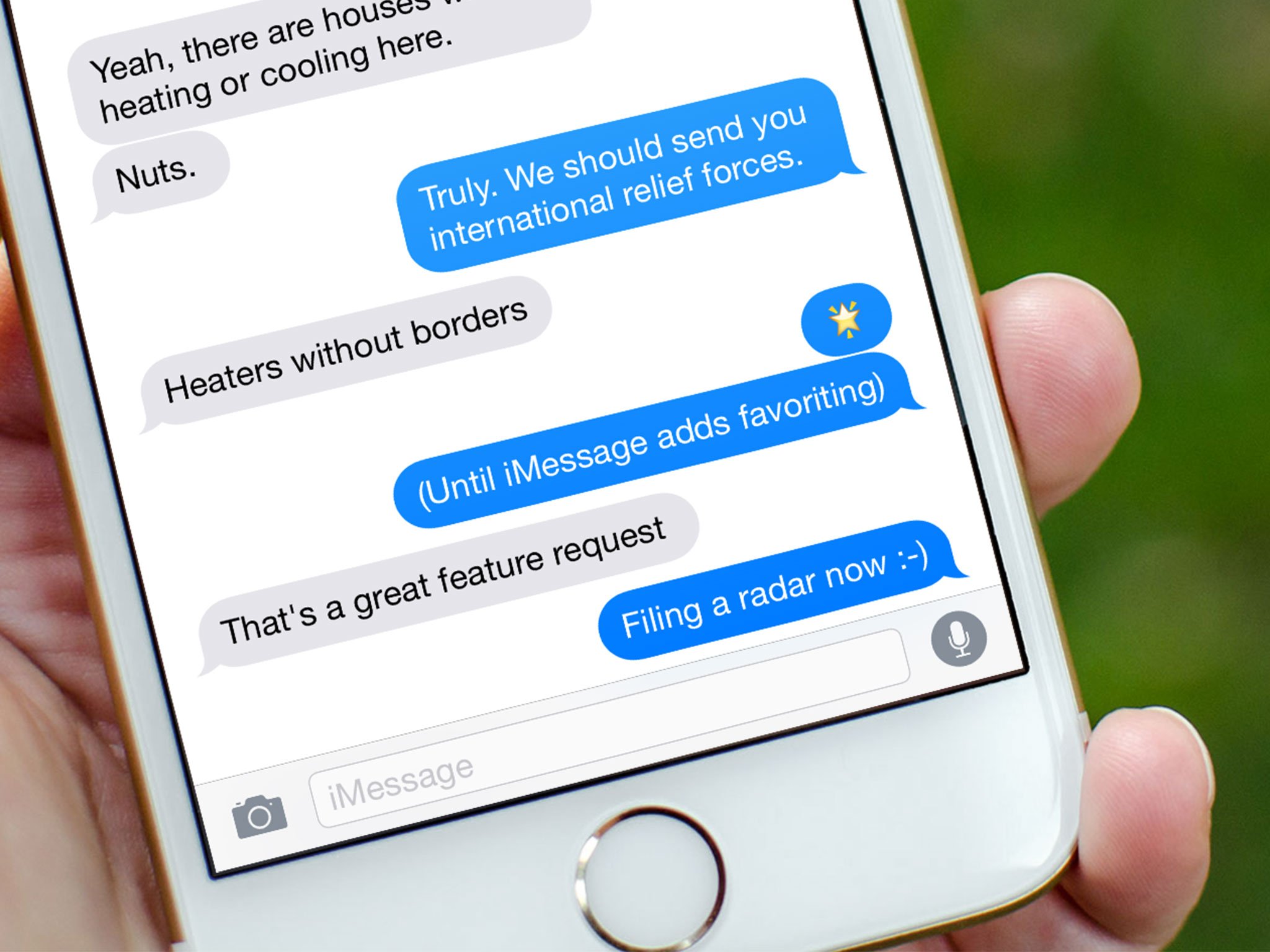Evolving iMessage

This year, iMessage will celebrate its fifth birthday. Recently, Eddy Cue and Craig Federighi appeared on John Gruber's Talk Show podcast and said that 200,000 messages are being sent through the Messages app every second at peak times.
iMessage and the Messages app on iOS and OS X have become a massive operation over the past five years, and yet it's hard to escape the sense that it remains a messaging app in a world increasingly dominated by messaging platforms. All this raises the question of where Apple should take iMessage next.
A world of messaging platforms
Messaging has evolved over the last few years from a simple, speedy method to exchange text, to including pictures and video, to becoming a world of its own, acting as a central hub for smartphone users and the other services they make use of. To be sure, this trend is far more prevalent in Asia, where services such as WeChat, LINE, and KakaoTalk have become far more than just messaging apps.
Services such as WeChat, LINE, and KakaoTalk have become far more than just messaging apps.
These apps have become meta-operating systems of their own, sitting on top of true mobile operating systems and absorbing more and more of their functionality. But this phenomenon is becoming increasingly global. Facebook, with Messenger, is increasingly trying to build very much the same sort of meta OS, and now has its own app store and integration with third parties like Uber.
Apple certainly doesn't need to become a platform in the same way for the same reasons. Those messaging platforms have embraced their strategy for two reasons: as a way to make money when messaging itself won't do the job, and as a way to create ecosystems of services following a failure to do so at the OS level. Neither of these things applies to Apple, which has a well-established and highly successful business model in selling hardware and associated services, and provides one of the two dominant mobile operating systems. However, iMessage exists in a world where these other messaging apps are becoming much more, and it therefore needs to evolve iMessage to remain competitive.
Three areas for expansion
To my mind, there are three areas in which Apple could evolve iMessage, should it choose to do so:
- Richer user functionality
- Developer integration
- A broader social play.
I'd argue that the first two are roughly equally important, and in fact reinforce each other, while the third is less important and more of a stretch goal for Apple.
Master your iPhone in minutes
iMore offers spot-on advice and guidance from our team of experts, with decades of Apple device experience to lean on. Learn more with iMore!
Richer user functionality
At the moment, iMessage is largely useful for sharing the things that SMS and MMS apps have always done: sharing text, photos, and videos. Since last year, it has also been able to share brief audio clips recorded on the fly, and with the addition of the Apple Watch it also serves as the bearer for slightly richer visual communications. But there are many forms of content which are either impossible to share via iMessage or which make for a poor experience when shared via iMessage. Even content from Apple's own apps and services shows up in un-optimized ways.
For example, sharing an Apple Music playlist, Apple News article, or Pages document through iMessage results in either an HTML link or a generic file icon. Neither provides a meaningful preview of the item in question or any other indication of what the content will be. Clicking on the Apple Music link bounces me out to the Music app and removes me from Messages.
If I'm in the middle of a conversation with a friend, and the friend shares some music with me, I want to listen to it right there in the app, not get bounced out to another app and have to come back to continue the conversation. If someone shares a file with me, I want to be able to see a preview of it in the thread, rather than a generic icon. If someone shares an Apple News article, I want to get either a snapshot of the page or the headline and first paragraph. All these things would enrich the user experience.
Another way in which Apple could enrich the user experience is to allow the sharing of more formats and file types through iMessage. Calendar invites that currently go through email could go through iMessage instead, especially for the younger generations that barely use email but live in messaging apps.
The most game-changing additional form of "content" Apple could add to iMessage would be money.
Apple could potentially allow iMessage to integrate with iCloud in such a way that the documents shared from iWork apps through iMessage would be the versions in iCloud, and any edits would be reflected on both ends of the conversation. There is so much Apple could do to turn what is presently a fairly static and disconnected experience into something richly integrated into the whole of iOS and OS X.
Perhaps the most game-changing additional form of "content" Apple could add to iMessage would be money. Venmo and others already offer easy peer-to-peer payments between friends, and their use among younger demographics is enormous – Venmo just announced that $7.5 billion crossed its system in 2015, and it already carried $1 billion in payments in January this year. With TouchID, Apple Pay, and other elements already in place, Apple is well positioned to add peer to peer payments to iMessage. The biggest hurdle would be getting past credit cards (a poor fit for P2P payments because of the fees) and to direct bank account access to fund payments. Whether it would use the ACH system and other equivalents or create its own standard is the next big question.
One other intriguing idea is using iMessage as another way to communicate with Siri. Siri is currently available only as either a voice-activated assistant or a search function on Apple's devices, but voice isn't always available as an option, and search isn't always what you need either. Being able to give Siri commands via a text-based interface could be really useful, and iMessage might be an obvious place for that functionality to live. Imagine being in a noisy (or conversely very quiet) place where Siri wouldn't work, but being able to type a quick instruction to Siri: "Send my wife my current location," "Put dinner with Sam on my calendar for Friday", "Add avocados to my grocery list" etc.
Developer integration

The second big way Apple could evolve iMessage is allowing app developers and businesses to use it to add value to their apps. Businesses and their customers in many Asian countries are already using messaging apps to communicate about orders, purchases, and customer service. But giving app developers access to iMessage SDKs would allow the same thing to flourish within Messages. Apple's strong privacy stance gives it a unique advantage here – as with Safari extensions, Apple would ensure that third parties never get any more information from the user than the user intends to share.
Creating MessageKit (the obvious counterpart to CloudKit and other similar "kits" Apple has provided to developers in recent years) would allow two possible scenarios:
- integration of iMessage within third party apps, as a communication channel between businesses and customers.
- integration of third party app extensions within iMessage, where elements of apps or possibly just a branded version of the standard iMessage chat window would appear within iMessage as just another message thread.
Matt Galligan has done a wonderful job imagining some of the possibilities of MessageKit, including some mockups, and I'd encourage you to read his Medium article for more on how this might work.
In addition to the obvious customer service stuff that's already been done elsewhere, there's a lot of potential in the "conversational UI" space too. Quartz's new news app for iOS has an intriguing message-based UI for consuming the news, for example, but would be so much more compelling if it lived in your Messages app rather than its own app.
Imagine Apple Pay deeply integrated into iMessage too, not just for peer to peer payments, but as a payment option during the course of an interaction with a company or brand. Allowing you to pay for goods or services while still in a message thread would be a great value-add and tap into functionality Apple has already built.
Another area where developers could potentially bring a richer experience to iMessage is through third party content sharing. Lots of the Asian messaging apps already offer stickers for users to insert into messages, while those and others also integrate with services such as Giphy to insert GIFs into messages.
This sort of thing isn't possible today in iMessage without copying and pasting from other apps, but being able to pull in content from these various sources and others would also enrich the experience. Imagine easily sharing the latest highlights from your favorite sports team, the weather in your location (or the place you're heading to with your communication partner), or other richer information. MessageKit could enable all these options with both Apple's own apps and third party apps.
A broader social play
The last and to my mind least likely way in which Apple could evolve iMessage is to turn it into the foundation of a broader social play. What I mean by this is that our messaging network is a form of social network already, but this social network is implicit and asynchronous rather than explicit and live or real-time.
Apple could create a proper social network around Apple IDs and iMessage.
If Apple were motivated to do so – and it's not clear that it is – it could create a proper social network around Apple IDs and iMessage. It already has some elements of this in place with iCloud Photo Sharing and everything that iMessage does. But it could allow users to create profiles of a sort around their iMessage handles, with things like recently read Apple News articles, favorite Apple Music playlists, and shared photos available as part of that profile to various friends based on permissions set by the user.
Such an exclusive social network would be a really interesting way to add value to the iOS ecosystem in particular, and would arguably have more pull for users than simply being a "blue bubble friend" rather than communicating with iOS users via SMS. Again, this is the part I'm least convinced about, but Apple has many of the components of such an offering already in place, and it would be an interesting new element of ecosystem lock-in if it did move ahead with it.
This summer could start the evolution
This summer's WWDC would be a great opportunity to start the evolution of iMessage down this road, with the announcement of MessageKit for developers potentially accompanied by other user-facing enhancements to the platform. The timing is arguably just right for this kind of move, because Apple hasn't missed the boat yet, but messaging platforms are becoming more prevalent and more dominant all the time.
Apple has the potential to do something much bigger with iMessage, and in the process to transform it from a simple messaging app into a true platform and a place where users will want to spend more and more time.
Jan Dawson is the founder and Chief Analyst of Jackdaw Research, an advisory firm focused on the consumer technology industry, from smartphones and tablets to music and video services to cloud storage and e-commerce. Jan also regularly writes for the Jackdaw Research blog, Beyond Devices, as well as for Techpinions, and is a contributor to both Recode and Yahoo Finance. You can find Jan on Twitter at @jandawson.

